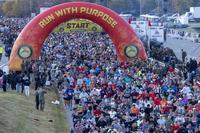It takes time to prepare for the demands of basic military training. The days are long, the physical activity is likely different from the workouts or sports recruits have done before, and it requires hours spent standing while wearing heavy equipment. This type of physical load requires workouts that reduce weaknesses and maintain strengths at the same time.
Every athlete who seeks to serve will start this process with a few strengths and more weaknesses than they may realize. Depending on the job they want to do in the military, some preparation training will take longer than others. If an athlete seeks to serve in regular military jobs (not special ops), the transition may not require significant time, as most young people in decent shape and a good athletic history can join most branches of service and be ready to go.
Here is an email from a young man getting ready to join the Army in a few months.
Hello, Mr. Smith. I am joining the Army after high school and was wondering how much time each day should I be training for basic training. I know the days are long there, but should my workouts be close to all day long, too? I’m curious as to how to get ready for the long days of training. Thanks for your time and the articles on the Military Fitness page. They have been helpful. Josh
How often you should train, how many repetitions you should do, how many miles you should run and how much weight you should lift depends on a combination of your athletic history, current fitness level, goals in the Army, selected military occupation specialties (MOS) and the time between now and when you leave for basic combat training (BCT).
Josh, first, thanks for choosing to serve. After a few more emails that followed my initial answer of “it depends,” I learned that Josh already has a decent foundation of physical training with sports in high school (football and track). He has taken a few Army physical fitness tests, and the new Army combat fitness test on his own. This type of preparation (and initiative) will go far in making sure he’s able to handle the physical demands of BCT.
My advice is to do manual labor tasks most of the day, either in your yard or neighborhood. You also could get a job where you are on your feet and moving and lifting things for several hours during a shift.
Then, either before or after work, get in your workouts to prepare specifically for the events you’ll see in the Army. These will include two-mile timed runs and longer runs. You also need to build up your rucking and load-bearing skills, and add in a healthy mix of calisthenics and weight training to prepare for group PT as well as the Army CFT events.
These workouts can be spread out throughout the week and last for one hour. However, rucking development takes time, and you should get in a few one- to two-hour rucks with 25% of your body weight since you’re already a runner.
However, if a person is joining and hasn’t done much physical activity, their preparation may be different.
If You Have No Athletic History
Treat yourself like a beginner. Do not jump into hardcore runs, high-rep calisthenics and weight training with no foundation. Joining as an out-of-shape and non-athletic candidate will lead to multiple issues during basic training, the kind typically caused by overuse injuries: tendinitis, rhabdomyolysis, shin pain, etc.
You do not have to be an athlete to have above-average levels of fitness, but you must work hard to get into condition. One day, your fitness level could be a determining factor in whether you, your buddy or others survive a life-or-death experience.
Your fitness level can be that serious, so start training now to meet and exceed the standards of the branch of service you seek. This may take some time and effort, but it will be worth it.
For individuals without a history of working out, it can take several months to build a decent foundation of fitness so they do not get hurt during training and can meet the standards required by their goals.
Although the fitness requirements are different in each branch of service, a candidate can meet them relatively quickly if they improve through smart and progressive workouts, such as running, high-repetition calisthenics and load-bearing activities.
To be safe, give yourself 4-6 months to focus on training for the tasks of your future military branch and job. By then, you will be more than ready to exceed the standards.
More workout and testing references:
Army CFT Workouts | Army CFT Leg Day
Training Consistency | Timed Run Preparation
Stew Smith is a former Navy SEAL and fitness author certified as a Strength and Conditioning Specialist (CSCS) with the National Strength and Conditioning Association. Visit his Fitness eBook store if you’re looking to start a workout program to create a healthy lifestyle. Send your fitness questions to stew@stewsmith.com.
Want to Learn More About Military Life?
Whether you're thinking of joining the military, looking for fitness and basic training tips, or keeping up with military life and benefits, Military.com has you covered. Subscribe to Military.com to have military news, updates and resources delivered directly to your inbox.



















